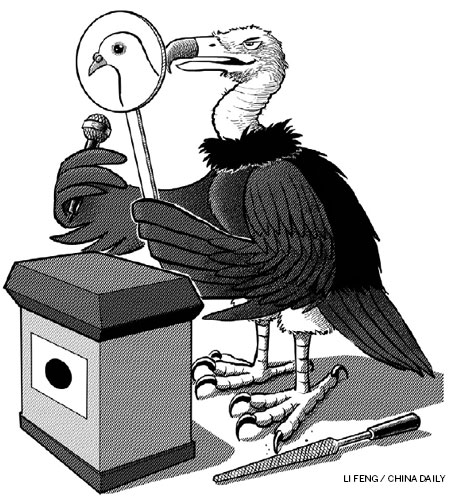Japan should stay away from China's safety range
- By Luo Yuan
 0 Comment(s)
0 Comment(s) Print
Print E-mail People's Daily, February 20, 2013
E-mail People's Daily, February 20, 2013

Recently, Japan has raised an increasingly fierce scandal about the "fire control radar targeting" incident in a preemptive attempt to shift the blame. Such behavior does not make sense in the following three aspects.
First, it reflects the lack of military knowledge on Japanese military and political officials. Japanese Defense Minister Itsunori Onodera claimed "Chinese navy frigate directed its fire control radar at destroyer 'Yudachi' of Japanese Maritime Self-Defense Force (MSDF) in the East China Sea at around 10 a.m. on Jan. 30" and that "the two ships were three kilometers apart at that time."
However, three kilometers would mean within visual distance, which indicates the ship borne artillery would be able to hit the target without being guided by the radar. It would be unnecessary for China to use the fire control radar. Say the radar is directing the target for the missile; people with the slightest military common sense would know that such short distance represents a blind corner for missile firing. The boosting device would have just fallen off within 1-2 kilometers after the missile was launched. The missile would be in the accelerating phase. The wing surface or the homing head would not yet have played their role.
Even if the fire control radar had been used, it would be impossible for the missile to effectively find the target, let alone posing any threat. Japan should have found a professional prior to slandering others. If the Americans were to believe this set of lies, it would be laughable for professional theorists.
Second, if the military aircrafts and warships were confronting in such close distance, China warship would have been neglecting its duty if it did not start alert and warning. Note that the reconnaissance and surveillance radar and the fire control radar are not the same thing. The former are used for comprehensive, long-distance, and large area search; the latter to carry out accurate designated lockdown on the basis of broad target provided by the former. These two have different radar wavelength and different lobes. The Japanese military should know this only too well since it have been carrying out electronic surveillance and intelligence gathering on China forces for a long time.
Moreover, if Japanese military aircrafts and warships come close for surveillance near China vessel formation, how can China warships sit quite and let it happen? How can China wait to be struck without even turning on the search and surveillance radar? Note that Japan has just threatened to shoot a warning bomb against China. Who knows whether the shot would turn out to be live ammunition or only a warning bomb? China has no choice but to be prepared. Even if Japan only fired a warning bomb, it would still be a physical threat; and even if China was targeting with searching radar, it would only be a photoelectric warning. It is not difficult to tell which case poses a greater danger.
Third, which party should be responsibility in case of an accidental discharge event? Undoubtedly it is the Japanese side. China vessel formation was carrying out normal training in the international waters. Why should Japan get close to reconnoiter and interfere with our normal navigation? Besides, such interference has not only happened once or twice. According to incomplete statistics, Japanese aircrafts came close for surveillance on China force for about 500 times every year, and interfered with our training far more often than that. Japanese warships often shadowed China vessel formation on our route with the snake-like interference and even vertical interference.
Any country's army will regard such behavior as a military provocation. Japanese military aircrafts are also used to play some dangerous moves. Lately, its F-15J fighter flew by China Transport-8 patrol with only 5 meters distance from its wing. A little astray would have resulted in ruin of the plane and death of people.
Provisions only allowing Japan to provoke and not allowing China for self-defense cannot happen.
In fact, Japan should know that the fact China did not use the fire control radar means China has let Japan off lightly. Although we did use the radar this time, it does not mean we are never going to use it. Once Japan poses a threat within short distance (but not the fabricated three kilometers distance which is a blind corner), China will have to send out warning and repel, and further, directly lock with the fire control radar. Any dangerous move from the counterpart, we will resolutely carry out self-defense leaving no room for negotiation, because passive means beaten with the life and death struggle on the battlefield.
The game rules in the East China Sea unilaterally raised by Japan have no ground. Japan should be aware that setting up air defense identification zone or firing warning bomb is not Japanese privilege. China can do the same.
In the East China Sea, China should have the right to impose legislative rules on Japan and Japan should stay away from the safety range of China!





